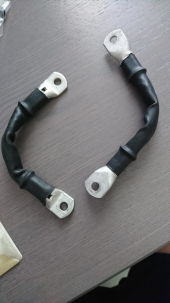My cell interconnect “cables” are very easily flexible enough to provide accommodate any movement of the cells in response to expansion or contraction during charge or discharge, which is small movement, if any at all. (I have the battery cells clamped under spring tension). I was just not comfortable with rigid bus bars for this reason.
As far as ampacity, I have three 24-volt, 280-amp-hour, lithium batteries in parallel. I never charge/discharge at more than 180 amps total, and rarely than much. My usual maximum charge current is 130 amps into the three parallel batteries. My discharge rate rarely exceeds 100 amps, so I don’t even come close to testing the current capacity limits of the 1/0 “flexible bus bars”. I am happy to have everything coasting gently along. Sorry, but I don’t have any experience at pushing them hard.
There really is no such thing as the exact, one true, ampacity of a cable. It depends upon the voltage drop you can tolerate, and/or the amount of energy waste you can tolerate, and/or how hot you can tolerate for the cable insulation to get.
Any standard 1 AWG wire (copper) has a resistance of about .013 ohms per 100 feet of length. In my 24-volt battery I have seven of these 1 AWG “flexible bus bars” that are 5 inches long each, or 35 inches in total. Rounding, this means that if 100 amps are pushed in or out of the battery, these seven “flexible bus bars” together will drop approximately (3/100 x .013 ohms X 100 amps) = .04 volts. The amount of power wasted will be (.04 volts x 100 amps) = 4 watts. Is that acceptable? If you draw 200 amps, the seven “flexible bus bars” together will drop .08 volts, and waste 16 watts of power. Is that acceptable? You decide.
NEC wire ampacity charts are based upon the maximum current that will result in heating of the wire that does not exceed temperature rating of the insulation, and no more than 10 percent voltage drop over the total wire length (out and back distance). This is usually for wiring in buildings. NEC ampacity charts are not very relevant for battery interconnects. This is why there is no definitive single ampacity number for welding/battery cables.




